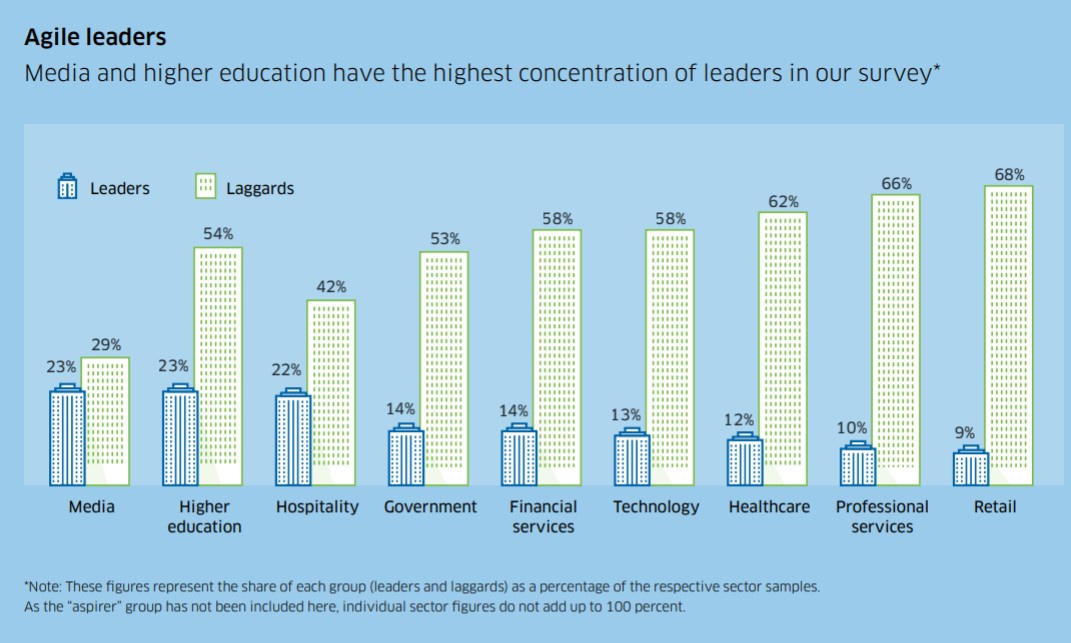Global Study: How Tech Companies Are Building Organisational Agility
Technology companies have many of the right pieces in place for organisational agility. How can they break through the most common barriers to achieving it?
Tech industry leaders know that they must evolve to survive. Whether a startup working to become profitable or an established company striving to keep up with rapidly changing consumer trends, organisational agility isn’t just nice to have anymore, it’s becoming a requirement.
Our global survey of 998 executives, “Organisational Agility at Scale: The Key to Driving Digital Growth”, shows that the majority recognise that organisational agility is key if they want to drive long-term digital growth. And, perhaps more tellingly, we found that there is a strong relationship between digital revenue growth and organisational agility.
We found that technology comes in fourth among the sectors predicting the highest digital revenue three years from now (the others, in order, are media, hospitality and higher education). But there is still some ground to make up in the strategic approach adopted for growth through digital.
We identified five key behaviours that are crucial to organisational agility, and then grouped survey respondents based on their level of adoption of these behaviours. “Leaders” (15% of respondents) achieved high performance across all five of the behaviours, while “aspirers” (30% of respondents) achieved high performance in four of them and “laggards” (55%) achieved three or fewer of the behaviours.
Here are the five behaviours that are necessary for organisational agility:
- Continuous planning. They plan in a continuous, real-time manner, which gives them the speed, agility and dynamism they need to innovate successfully.
- Fluid structures and processes. Leading organisations build fluid organisational structures and processes. Nearly half claim the ability to reallocate people quickly to where their skills are needed.
- Building the future workforce. Leaders are much more likely than laggards to have plans to upskill the majority of their workforce and push specific initiatives to increase employee engagement.
- Informed and empowered decision-making. At 80% of organisations that rank as leaders, all employees have access to timely and relevant data and are empowered to make appropriate decisions.
- Measurement and guidance. Leaders have made significant progress in developing tools and metrics to measure the performance of digitally driven innovations. This is giving them a “fail fast” mentality: 94% say they are able to steer away quickly from unsuccessful projects.
Our survey broke down organisational agility by industry. In the technology industry, 13% were identified as leaders, a rather surprising 58% were identified as laggards and 29% were aspirers.

Here are a few key insights from survey respondents from technology companies:
- Digital revenue streams are here to stay. Forty-four percent expect digital revenue to make up over 50% of their revenue three years from now.
- Digital innovation takes agility. Seventy-seven percent said that their strategy for growth by digital innovation is always evolving.
- Tech companies are ready to make the right moves. Sixty-seven percent shared that they’re ready to move people when new opportunities arise or their skills are needed elsewhere. But those that can’t reallocate people when and where needed (14%) say bureaucratic culture is their biggest roadblock.
- Doors to upskilling are open. Seventy-three percent said that employees in their companies are encouraged to grow through learning new skills.
- Frontline workers get the investment they deserve. Sixty-six percent said that customer-facing employees (the “frontline”) have the power to make decisions to improve the customer experience.
- Access to digital tools. They don’t have access to the data and tools they need to measure the performance of new digital products and service lines.
Challenges for Organisational Agility
Though many technology companies are putting the right pieces in place, it’s not always easy to work toward the five behaviours that make organisational agility a reality, at scale.
The changing world of work is making it more and more important to plan in real time. Technology companies want to move toward real-time, integrated planning, but their most common barriers to accomplishing this are inflexible legacy technologies, bureaucratic organisational cultures and a lack of relevant employee skills.
They also strive to update business processes to respond to the changing needs of their business, but they struggle against similar barriers: bureaucracy, inflexible legacy technologies and an unwillingness to move away from that legacy tech.
Measuring the Right Things with the Right Data
Two keys for technology companies to achieve true organisational agility are setting the right KPIs and ensuring that the right data is accessible to relevant stakeholders.
Fifty-six percent of technology executives said their company’s KPIs don’t reflect the current digital era. That reinforces the idea that a key starting point in the journey to organisational agility is making sure you’re working toward and measuring the right things. When you start in the right place, you start in the right direction toward leading in the digital era.
The second key to success in organisational agility is ensuring the right people have access to the data they need. Tech executives shared that when it comes to data, only 46% have access to all the relevant data they need. Over half said their data is often siloed and outdated. And only 18% of employees had access to the data they need to respond to customers.
To make real progress toward the benefits of organisational agility, technology companies should focus on setting the right goals and ensuring the right stakeholders have access to the data they need.
Get an overview of findings from “Organisational Agility at Scale: The Key to Driving Digital Growth” or download the full report.